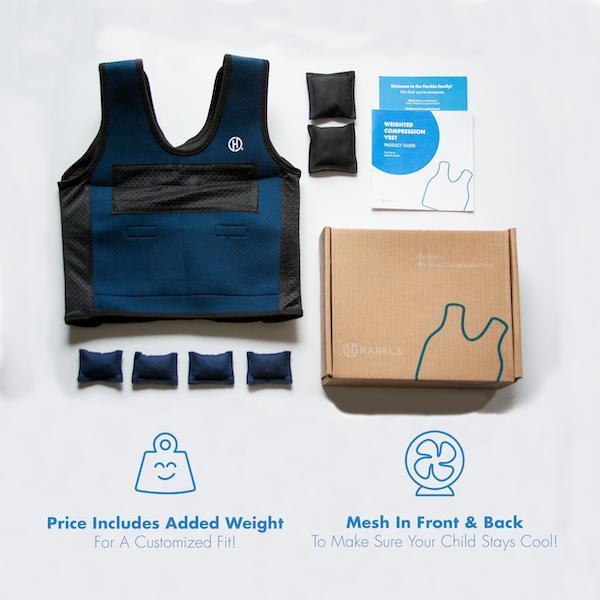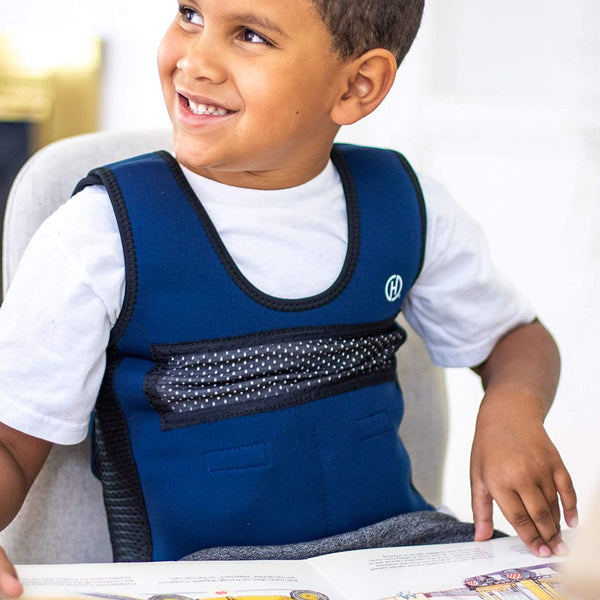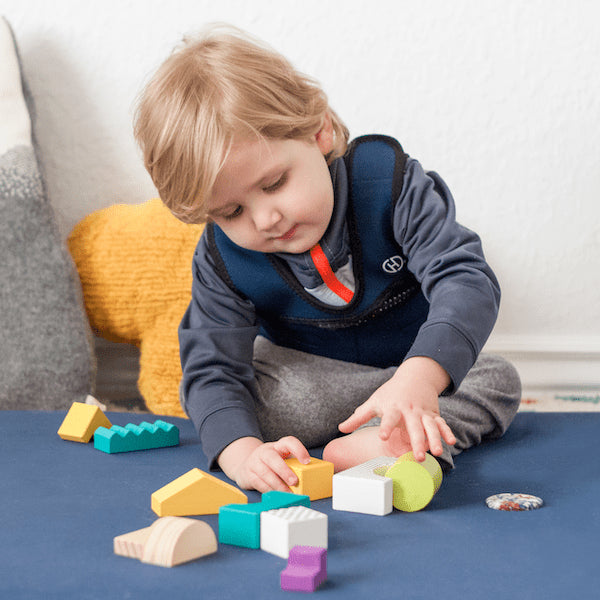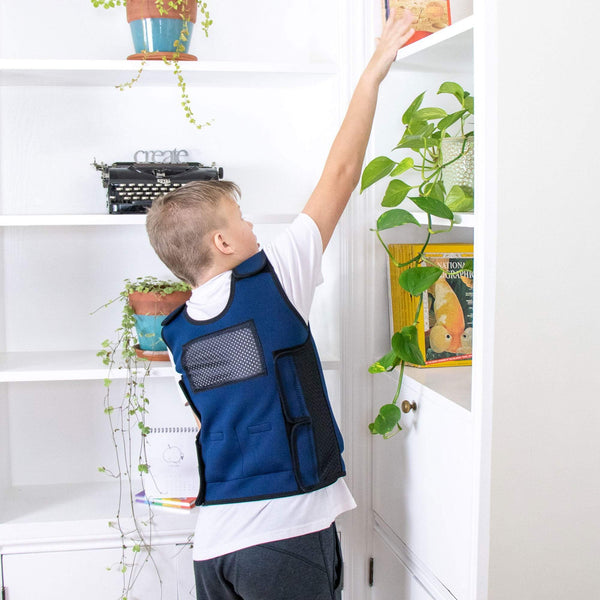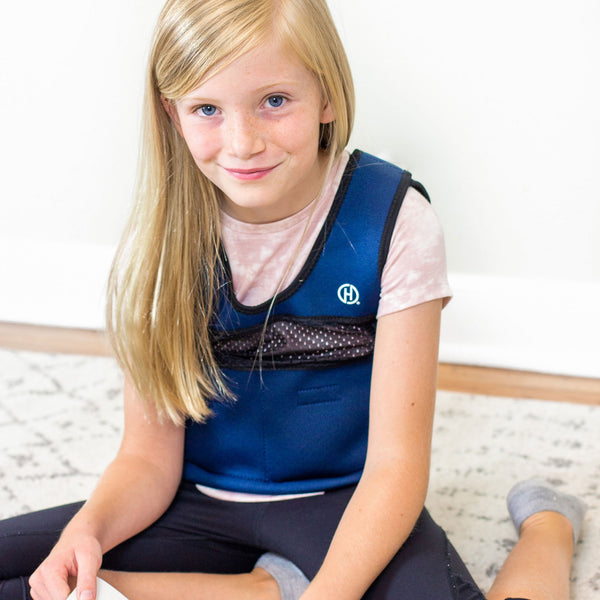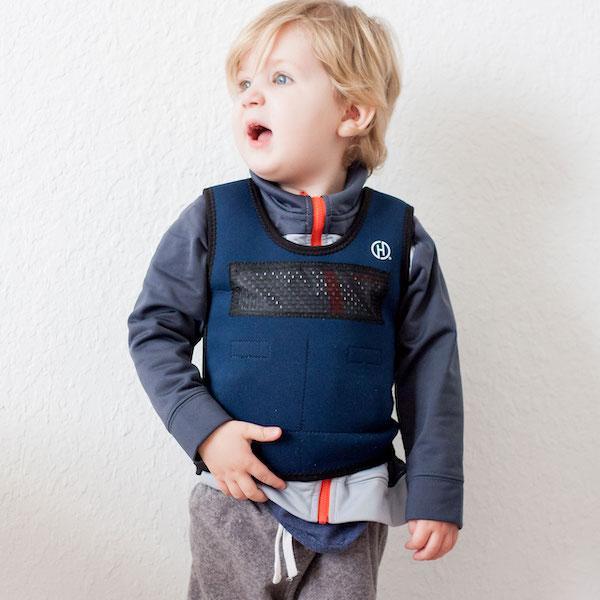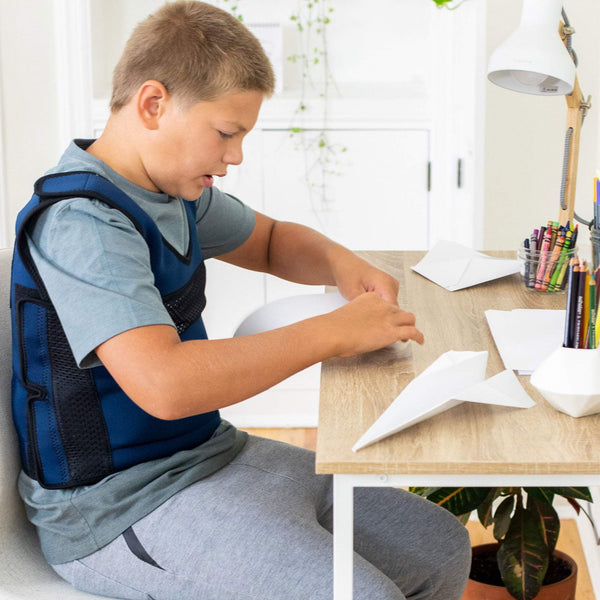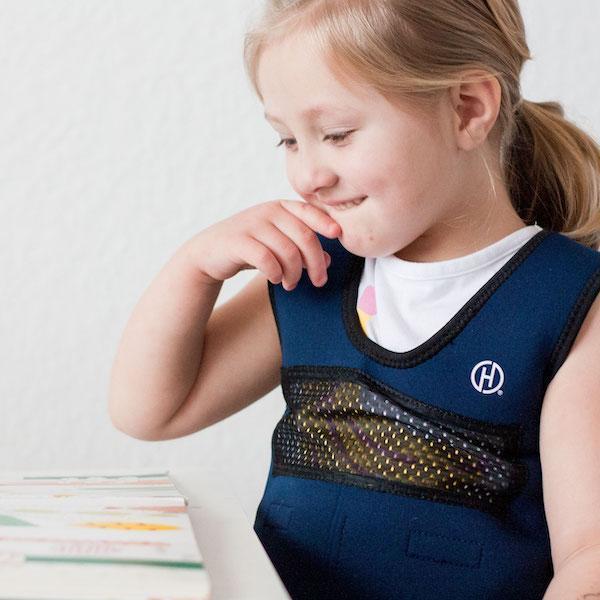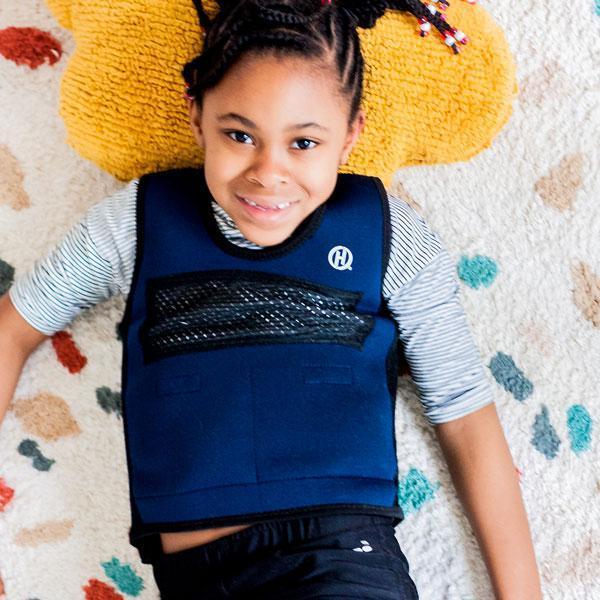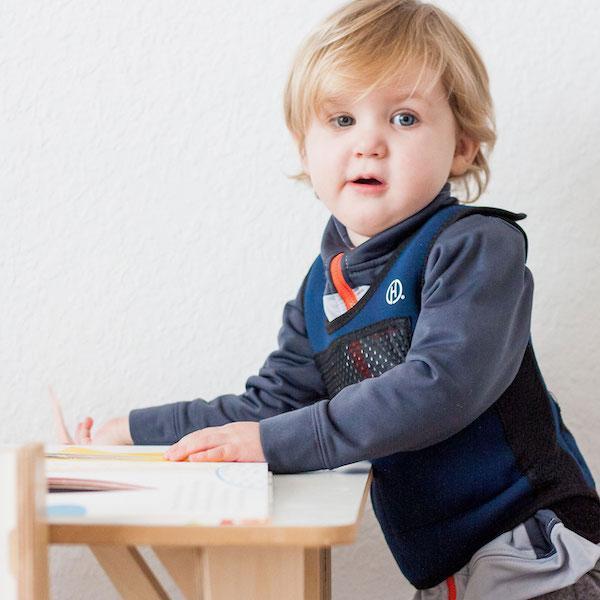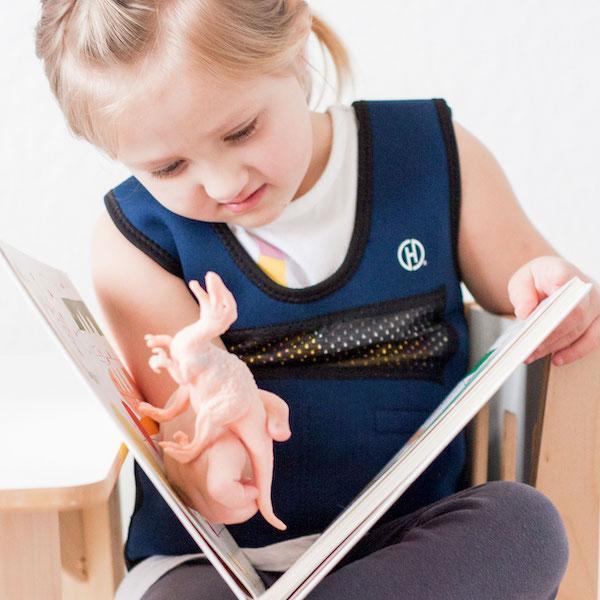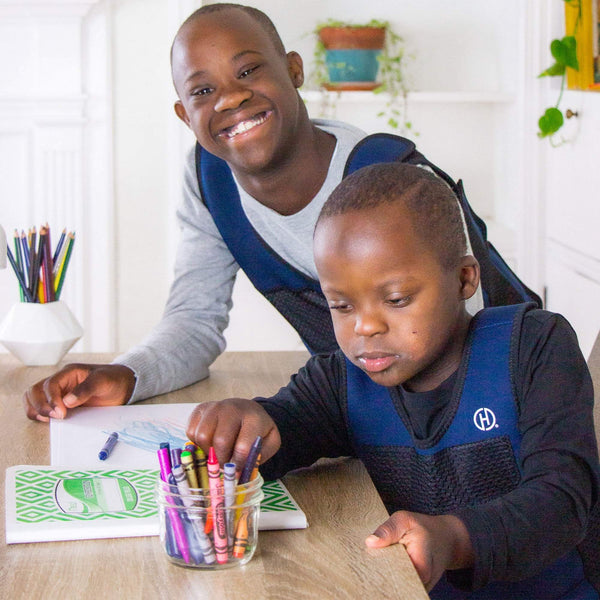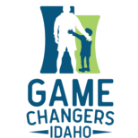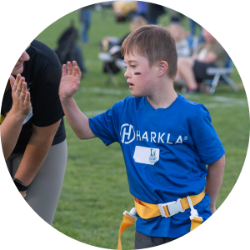Description MATERIALS:
Soft Neoprene, Mesh, Velcro
MEASUREMENTS:
Small: 21-26 inches wide x 13-14 inches long
Medium: 24-30 inches wide x 15-16 inches long
Large: 28-34 inches wide x 18-19 inches long
WHAT'S INCLUDED:
Harkla Weighted Compression Vest
2lbs of weight: (4) 1⁄4 lb weights & (2) 1⁄2 lb weights
INTERIOR WEIGHT POCKETS:
2 pockets on the front
4 pockets on the back
Are you looking for a tool to help your child feel secure, calm, and focused?
Harkla’s weighted compression vest for kids with sensory issues, autism, and ADHD combines the sensory input tool with a wearable by applying pressure to sensitive areas of the body. Simply place the vest over your child's clothing, and watch your little one return to feeling grounded and in control.
A perfect addition to the classroom, pack the weighted compression vest with your child's school supplies for on-the-go sensory integration therapy. It works well on travel, too! Improve both their and your car rides with a vest providing deep pressure sensory input.
The compression weighted vest for kids is made out of soft neoprene and is built to last. Unlike other brands, Harkla has built-in ventilation using mesh to make sure your child stays cool while receiving the sensory integration therapy benefits.
Sizing Chart The Harkla Weighted Compression Vest Is Designed To Be:
5-10% OF YOUR BODYWEIGHT
We recommend that you measure your child to ensure purchasing the correct size. The width is measured by taking the circumference of the torso. The length is measured by taking the measurement from the top of the shoulder to the waist. Is your child between sizes or on the higher end? We recommend you size up.
Who We Are We think children with special needs should have every opportunity to live happy and healthy lives. That's why Harkla is dedicated to providing families with the best products and resources for raising a special needs child. Read more of our story here.
FAQS Does The Compression Vest Come With Added Weight?
Yes! We will send you extra weights to add to the vest. Additionally, you can buy more weights at this link.
Who Could Benefit From A Compression Vest?
Weighted vests are typically used for children with sensory issues, autism spectrum disorder, or ADHD. The vest helps the child calm down and focus better. You can read our article here on the benefits of weighted vests.
What’s The Difference Between A Weighted Vest & A Compression Vest?
Some vests you will find will provide only compression or only weights. These can work great if you only need one of those features for your child.
While both accomplish similar things, the compression is designed to help with your child's calmness from the deep touch pressure. The weight provides that, but also provides a groundedness that can come from the extra weight. If you'd like to read more about the differences, check out our blog post here.
Fortunately, our vest is both a compression vest and weighted vest to give you the best of both worlds!
What Happens If The Vest Gets Damaged From Use?
Things happen! We maintain our product lifetime guarantee for the weighted compression vest. Unless you are 100% satisfied, we aren’t satisfied either. We're a company that truly cares about you and will answer any questions or concerns you have.
Once you get your product, simply visit harkla.co/warranty to register your warranty.
Where Do We Ship This Product?
From the Harkla Website, we only ship this product to the United States.
However, if you are looking for us in another country, we have options for purchasing!
Canada: Shop our store on Amazon Canada
Australia: Shop for us with our Australian Partner Starfish
If you're looking for another country, please check out our partner page to see if our products are available in your country through another retailer!
If you’d like to be informed of when we will be shipping to your country, please contact our customer service: support@harkla.co
Related Articles
When it comes to the benefits of weighted vests for autism and sensory challenges, it's important to first understand the relationship between weighted vests and sensory processing disorder.
AUTISM AND SENSORY PROCESSING DISORDER
In our article, What You Need to Know about Sensory Issues & Autism, we outlined the statistics and connections between sensory processing disorder and autism spectrum disorder. The STAR institute estimates, based on their research, that 75% of children with autism have “significant symptoms of sensory processing disorder.”
For people with autism, sensory processing dysfunction can manifest in language delays or deficits, fine and gross motor delays, strong sensory interests, sensory aversions, an inability to interact with people and objects, an inability to stay within an interaction, repetitive sensory stereotypies (stimming), and much more.
If you have a child with autism, his/her occupational therapist may have recommended a weighted vest to help with hyperactivity, focus, and/or self-stimulatory behaviors.
For people with autism, sensory processing dysfunction can manifest in language delays or deficits, fine and gross motor delays, strong sensory interests, sensory aversions, an inability to interact with people and objects, an inability to stay within an interaction, repetitive sensory stereotypies (stimming), and much more.
If you have a child with autism, his/her occupational therapist may have recommended a weighted vest to help with hyperactivity, focus, and/or self-stimulatory behaviors.
DEEP TOUCH PRESSURE
A weighted vest provides deep touch pressure (DTP), or proprioceptive input, which has a calming, organizing effect on the child.
Occupational therapists often recommend wearables that provide deep touch pressure as part of a comprehensive sensory diet to help children with autism who have sensory processing disorder or self-regulation difficulties.
10 BENEFITS OF WEIGHTED VESTS
So, what is the takeaway as a parent when looking at conflicting research behind a recommended treatment approach?
Know what you want to see change with your child. What is the intended purpose of the weighted vest - focus, attention, body awareness, staying seated? If you know what to look at, you’ll be better able to speak to your child’s response to a weighted vest.
If you’re a parent of a child with autism, you know that not every tool, strategy, or approach works the same for every child. A weighted vest is no different!
Here are the 10 benefits that have been reported by weighted vest wearers, therapists, and parents: - Increased focus/attention
- Increased seated time-on-task
- Decrease self-stimulatory behaviors
- Promote calm and organization
- Decreases hyperactivity
- Reduce anxiety
- Assist with self-regulation
- Reduced frequency of sensory overload
- Improved body awareness
- Increases therapeutic carryover of sensory diet activities
More Info
WHAT IS A WEIGHTED VEST?
If you are unfamiliar with the basics of what a weighted vest is, it’s not overly complicated! A weighted vest is just that: a vest-like garment that is worn over clothing, with some additional weight either sewn into pockets or embedded in the fabric lining.
A weighted vest provides deep touch pressure (DTP), or proprioceptive input, which has a calming, organizing effect on the child.
Occupational therapists often recommend wearables that provide deep touch pressure as part of a comprehensive sensory diet to help children with autism who have sensory processing disorder or self-regulation difficulties.
RESEARCHING WEIGHTED VESTS
While weighted vests are a common recommendation by occupational therapists, the research behind these sensory tools is inconsistent depending on the targeted outcome.
A 2001 study published in American Journal of Occupational Therapy by Nancy L. VandenBerg, found that on-task behavior increased by 18-25% in all four subjects when a weighted vest was worn for tabletop fine motor tasks. Additionally, 3 of 4 subjects asked to wear the weighted vest beyond the testing periods.
Similar positive outcomes were noted in the 2001 study published in the American Journal of Occupational Therapy by Doreen Fertel-Daly, Gary Bedell, Jim Hinojosa that looked at the positive effects of weighted vests on attention to task and decreasing self-stimulatory behaviors in preschoolers with Pervasive Developmental Disorder.
The research behind deep touch pressure is supportive for promoting physiological regulation (respiration rate, heart rate, blood pressure) and reducing anxiety. Since the design and purpose of weighted vests and compression vests target the proprioceptive system by increasing the amount of input, it is logical to make the connection that the positive findings of DTP research would also be the case in product-specific research.
Unfortunately, the research on the effectiveness of weighted vests has been inconsistent through the years and additional research is necessary to build consensus.
More research is needed to better understand and measure the observable changes with these products - from sensory, behavioral, attention, and social-emotional perspectives. However, subjective data from parents, therapists, and children is overwhelmingly positive and warrants an individualized approach to exploring weighted vests as sensory tools for your own toolbox.
WEIGHTED COMPRESSION VEST OPTION FOR CHILDREN
Children who fidget excessively, demonstrate difficulties with attention and impulsivity, or have difficulty with body awareness may benefit from a compression-style vest or garment. These products can be worn to provide additional sensory input (proprioception) about where one’s body is in space (body awareness).
A wearing schedule is recommended and can vary based on your child’s needs. It is important to consult your occupational therapist for an individually-designed wearing schedule, but generally, it could be 20-30 minutes worn, 20-30 minutes off, or activity-based duration.
Some parents and educators feel that compression vests are helpful during especially stressful times (i.e. school assemblies, doctor’s appointments). Should your child require additional, more consistent input throughout the day, consider adding a tight-fitting undershirt (lycra-based).
WEIGHTED VESTS OR WEARABLES FOR CHILDREN
Weighted vests come in a number of styles, fabrics, and weight options. No matter the design, the functionality of the vest is dependent on the amount of weight worn. There is no good research to support a hard-fast rule for how much to weight a vest, but 5-10% of the child’s total body weight is accepted as a safe limit for backpack weights and can be applied without risk of injury to developing bones and joints.
Reasons for recommending a weighted vest can include: increase focus/attention in the classroom, decrease self-stimulatory behaviors (stimming), and promote calm and self-regulation.
Much like the compression vests, the wearing schedule should be advised by your child’s occupational therapist and should be paired with an activity. Some people notice improvements after wearing a weighted vest/garment for just 15 minutes, but with every sensory intervention, every child responds differently.
Somewhat new to the market are varied sources of weight - you’re no longer restricted to just buying “vests” - weighted wearables are available as belts, lap pads, weighted animals, and even suspenders!
However you’re looking to incorporate a weighted wearable, be sure to consider social perception and the level of awareness of your child and his peers when making your selection.
WEIGHTED COMPRESSION VESTS AND WEARABLES
For some kids, just compression or just weight isn’t going to offer enough sensory input. Some wearables offer a combination of the weighted garment in compression fabrics and designs. Pair it with a tight-fitting compression undershirt for a super sensory dose of input!





